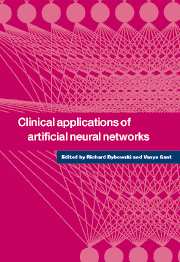Book contents
- Frontmatter
- Contents
- List of contributors
- 1 Introduction
- Part I Applications
- Part II Prospects
- 8 Recent advances in EEG signal analysis and classification
- 9 Adaptive resonance theory: a foundation for ‘apprentice’ systems in clinical decision support?
- 10 Evolving artificial neural networks
- Part III Theory
- Part IV Ethics and clinical prospects
- Index
8 - Recent advances in EEG signal analysis and classification
Published online by Cambridge University Press: 06 October 2009
- Frontmatter
- Contents
- List of contributors
- 1 Introduction
- Part I Applications
- Part II Prospects
- 8 Recent advances in EEG signal analysis and classification
- 9 Adaptive resonance theory: a foundation for ‘apprentice’ systems in clinical decision support?
- 10 Evolving artificial neural networks
- Part III Theory
- Part IV Ethics and clinical prospects
- Index
Summary
Introduction
Electrical signals recorded from the scalp of human subjects, or electroencephalographic (EEG) signals, were first studied extensively by Berger (1929). Since these initial experiments, investigators in many branches of science, including physics, medicine, neuroscience, and psychology, have searched for meaningful patterns in EEG signals (Pilgreen 1995). For example, the analysis of patterns in EEG has for some time been extremely useful in the study and treatment of epilepsy (Kellaway & Petersen 1976).
Many of the traditional approaches to EEG pattern analysis that have been employed during the last six decades are based on visual inspection of graphs of voltage amplitude over time, or on the inspection of spectra showing the energy with which various frequencies appear in the signal. However, recent advances in signal analysis and classification using artificial neural networks have led to significant, new results in the filtering and interpretation of EEG signals. This chapter describes some of these new approaches as they are applied to EEG signals surrounding a response to a stimulus and to spontaneous EEG signals recorded while subjects perform mental tasks. Applications of these approaches include the study of sensory, motor and cognitive processing in the brain, and the development of brain–computer interfaces to provide a new avenue for communication with locked-in patients suffering from advanced anterolateral sclerosis (ALS).
Effect of attention on spectral dynamics of event related potentials
The event-related potential, or ERP, is simply the EEG recorded in response to a time-locked stimulus.
- Type
- Chapter
- Information
- Clinical Applications of Artificial Neural Networks , pp. 175 - 191Publisher: Cambridge University PressPrint publication year: 2001
- 2
- Cited by

